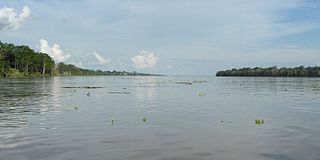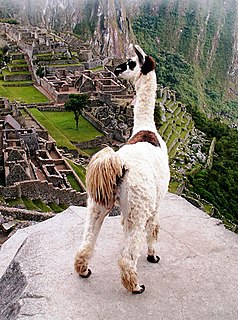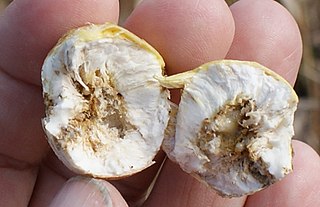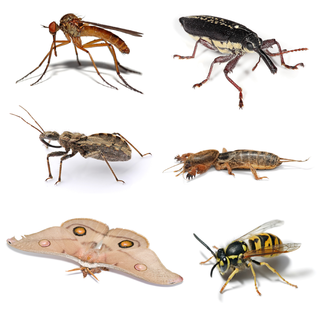
The Amazon River in South America is the largest river by discharge volume of water in the world, and by some definitions it is the longest.

Rio Branco is a Brazilian municipality, capital of the state of Acre. Located in the valley of the Acre River in northern Brazil, it is the most populous municipality in the state, with 319,825 inhabitants – almost half the state population, according to the 2011 census.

Corydoras is a genus of freshwater catfish in the family Callichthyidae and subfamily Corydoradinae. The species usually have more restricted areas of endemism than other callichthyids, but the area of distribution of the entire genus almost equals the area of distribution of the family, except for Panama where Corydoras is not present. Corydoras species are distributed in South America where found east of the Andes to the Atlantic coast, from Trinidad to the Río de la Plata drainage in northern Argentina. Species assigned to Corydoras display a broad diversity of body shapes and coloration. Corydoras are small fish, ranging from 2.5 to 12 cm in SL., and are protected from predators by their body armor and by their sharp, typically venomous spines.

The Paraíba do Sul, or simply termed Paraíba, is a river in southeast Brazil. It flows 1,137 km (706 mi) west to northeast from its farthest source at the source of the river Paraitinga to the sea near Campos dos Goytacazes. The river receives its name when it meets the river Paraibuna at the Paraibuna dam.

The Rio Mayo titi is a species of titi, a type of New World monkey, endemic to Peru. The Rio Mayo titi, was thought previously to have a small range of origin in the Alto Mayo valley, but research has proven that the range extends southward and reaches the Huayamba River, as well as Bajo Mayo. It had been classified as vulnerable but due to major habitat loss and restricted living space, it is now classified as Critically Endangered. In October 2012, it was included in The World's 25 Most Endangered Primates list. An increase in deforestation is leading to the decrease in available living space for this titi monkey, forcing it to live in sympatry with another species of Callicebus. Yet in some areas, such drastic deforestation has resulted in extremely high population density. The Rio Mayo titi is better adapted to moderately populated areas, thus overpopulation negatively impacts the species. The forests the Rio Mayo titi lives in are being destroyed for agricultural purposes, leaving little forest for the monkeys. They were only seen a few times and featured in museums until 2003 when more research was done on them. In order for this species to survive, their forests need to be protected to avoid overpopulation. Different conservation groups are working to help P. oenanthe survive. Neotropical Primate Conservation, Proyecto Mono Tocón and Amazónicos para la Amazonia are working in the more southern areas to protect the monkey. The Rio Mayo titi is a fairly inconspicuous creature, making observation and research difficult to obtain. Therefore, the traditional use of transect observation to monitor the monkey's population, is less effective. Instead, other methods of calculating the titi monkey's density in certain areas have been taken, such as research into the species-specific calls endemic to a certain area.

The marsh deer is the largest deer species from South America reaching a length of 2 m (6.6 ft) and a shoulder height of 1.2 m (3.9 ft). It is found in Argentina, Bolivia, Peru, Brazil, Uruguay and Paraguay. Formerly found in much of tropical and subtropical South America, it ranged east of the Andes, south from the Amazon rainforest, west of the Brazilian Atlantic rainforest and north of the Argentinian Pampa. Today it is largely reduced to isolated populations at marsh and lagoon zones in the Paraná, Paraguay, Araguaia and Guapore river basins. Small populations also occur in the southern Amazon, including Peru where protected in Bahuaja-Sonene National Park. It is listed as a vulnerable species by the IUCN and on CITES Appendix I.

Guaibasaurus is an extinct genus of basal dinosaur known from the Late Triassic Caturrita Formation of Rio Grande do Sul, southern Brazil.

Bahuaja-Sonene National Park is a protected area located in the regions of Puno and Madre de Dios, in Peru.

Sacisaurus is a silesaurid dinosauriform from the Late Triassic (Norian) Caturrita Formation of southern Brazil. The scientific name, Sacisaurus agudoensis, refers to the city where the species was found, Agudo in the Rio Grande do Sul state, whereas Sacisaurus refers to Saci, a famous one-legged creature from Brazilian mythology, because the fossil skeleton was found with a leg missing.

Loricariinae is a subfamily of the family Loricariidae of catfish. This subfamily is divided into two tribes and about 30 genera. They are mainly native to freshwater habitats in South America, but there are also several species in Panama and a single (Fonchiiichthys) in Costa Rica.
Rhadinoloricaria macromystax is the only species of the monotypic genus Rhadinoloricaria, a genus of the family Loricariidae of catfish.

Crossoloricaria is a genus of armored catfish native to South America with one species ranging into Central America.

Pseudacanthicus is a genus of medium to large-sized suckermouth armored catfishes native to South America, where found in the Amazon and Orinoco basins, as well as rivers of the Guianas. They are primarily found in fast-flowing waters, sometimes relatively deep. They are sometimes kept in aquariums.
Tambopata District is one of four districts of the Tambopata Province in the Madre de Dios Region in Peru.

A caiman is an alligatorid crocodilian belonging to the subfamily Caimaninae, one of two primary lineages within Alligatoridae, the other being alligators.
Crossoloricaria cephalaspis is a species of armored catfish. It is endemic to Colombia where it is found in the Magdalena River basin. This species grows to a length of 10.9 centimetres (4.3 in) SL.

Crossoloricaria variegata is a species of armored catfish native to Panama where it is found in the Mamoní, Tuira and Yape River basins and Colombia where it is found in the San Juan and Sinú River basins. This species grows to a length of 26.5 centimetres (10.4 in) SL.
Crossoloricaria venezuelae is a species of armored catfish found in the Lake Maracaibo drainage of Venezuela and Colombia. This species grows to a length of 18.3 centimetres (7.2 in) SL.

Peru has some of the greatest biodiversity in the world because of the presence of the Andes, Amazon Rainforest, and the Pacific Ocean.

The Peruvian Yungas is a tropical and subtropical moist broadleaf forest ecoregion in the Yungas of Peru.




















